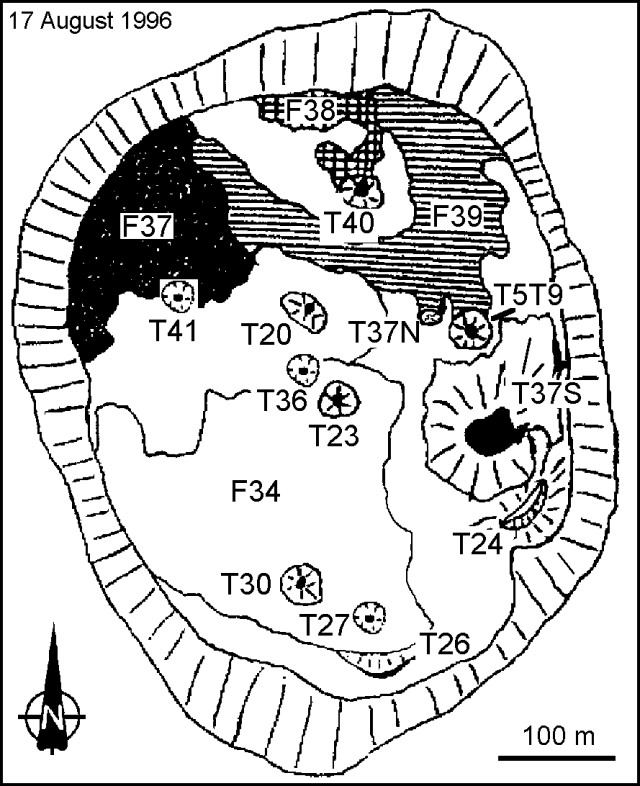Report on Ol Doinyo Lengai (Tanzania) — April 1998
Bulletin of the Global Volcanism Network, vol. 23, no. 4 (April 1998)
Managing Editor: Richard Wunderman.
Ol Doinyo Lengai (Tanzania) July 1997 visit reveals lapilli ejections, lava flows
Please cite this report as:
Global Volcanism Program, 1998. Report on Ol Doinyo Lengai (Tanzania) (Wunderman, R., ed.). Bulletin of the Global Volcanism Network, 23:4. Smithsonian Institution. https://doi.org/10.5479/si.GVP.BGVN199804-222120
Ol Doinyo Lengai
Tanzania
2.764°S, 35.914°E; summit elev. 2962 m
All times are local (unless otherwise noted)
F. Belton, an amateur volcano watcher, climbed to the crater and observed its activity for five hours on 17 July 1997. He saw solid lapilli ejecting from a hornito in the vicinity of T23 (figure 47). The lapilli discharged irregularly and rose no higher than 2-3 m above the vent, falling on the hornito's flank or within 3 m of its base. The largest ejected fragment was ~5 cm long; most were much smaller. Some discharges were accompanied by noisy gas puffs.
 |
Figure 47. Sketch map of the Ol Doinyo Lengai crater, 17 August 1996. Courtesy of Christoph Weber, revised by C. Nyamweru. |
A large crater, not shown on the map but located NW of T20 between T41 and T40 (figure 47), was elongated and ~3 m deep. It contained a vertical vent with vigorously churning lava that could be heard across the summit area. Another climber reported to Belton that on 13 July 1997 this crater was nearly overflowing with churning lava.
The highest point on this unnamed crater's rim was at the NE end above its active vent. There the rim formed a hollow dome, evidently the result of low fountaining from the vent. Although lava had recently spattered over the rim along the entire circumference of the crater, most of the outflow passed through a large, well-formed tube on the crater's NW side. The tube was the primary feed for a pahoehoe flow that was large, fresh (
Another hornito, identified as T41 (figure 47), was small and circular. Although it produced noise, its overhanging rim prohibited Belton from making closer observations. Sloshing lava was also be heard inside three older hornitos, tentatively identified as T36, T40 , and T37S (figure 47); heated air was rising above their vents. The T40 hornito had two peaks, each with a circular vent. Although no visible gas discharged from either vent, a wooden walking stick held over a vent ignited after about 8 seconds. Another, currently inactive hornito, possibly the feature labeled T37S in figure 47, had a wide crater with an overhanging rim at its summit. The crater contained a small rounded cone with a rectangular summit vent.
Geological Summary. The symmetrical Ol Doinyo Lengai is the only volcano known to have erupted carbonatite tephras and lavas in historical time. The prominent stratovolcano, known to the Maasai as "The Mountain of God," rises abruptly above the broad plain south of Lake Natron in the Gregory Rift Valley. The cone-building stage ended about 15,000 years ago and was followed by periodic ejection of natrocarbonatitic and nephelinite tephra during the Holocene. Historical eruptions have consisted of smaller tephra ejections and emission of numerous natrocarbonatitic lava flows on the floor of the summit crater and occasionally down the upper flanks. The depth and morphology of the northern crater have changed dramatically during the course of historical eruptions, ranging from steep crater walls about 200 m deep in the mid-20th century to shallow platforms mostly filling the crater. Long-term lava effusion in the summit crater beginning in 1983 had by the turn of the century mostly filled the northern crater; by late 1998 lava had begun overflowing the crater rim.
Information Contacts: Frederick Belton, 3555 Philsdale Ave., Memphis, Tennessee 38111, USA.

